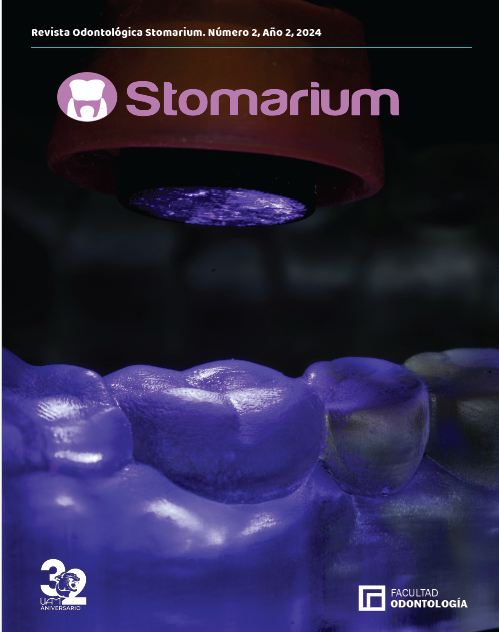Effect of grape seed extract and essential oil on enamel bonding strength post-treatment of teeth whitening with 35% hydrogen peroxide
DOI:
https://doi.org/10.62407/ros.v2i2.175Keywords:
Antioxidants, tooth bleaching, dental enamel (Mesh)Abstract
Background: Immediately after tooth whitening, the bond strength between the adhesive materials and enamel decreases, it is necessary to wait between 7 to 21 days for adhesive procedures. Objective: To evaluate the bonding resistance to enamel exposed to different antioxidants after whitening treatment with 35% hydrogen peroxide. Materials and methods: Bovine teeth were used. All the specimens received whitening treatment with 35% hydrogen peroxide, two applications of 15 minutes each were made, for two sessions every 7 days. After the treatment, the specimens were randomized to receive the different antioxidants for 10 minutes on the enamel. evaluating four groups: grape seed oil (ASU), 5% grape seed extract (ESU); negative control (bleaching without antioxidant) and positive control (without bleaching and without antioxidant). Subsequently, the restorative treatment with fluid resin was carried out. The micro shear test was used on the universal machine. The ANOVA test was used to compare the binding resistance values of the different groups evaluated, assuming normality. Results: It was found that the groups exposed to antioxidants presented the lowest values of binding resistance when compared with the group without bleaching, without significant differences between the fixed oil of ESU 8.09 (3.24) MPa and the seed extract grape 8.08 (3.79) MPa (p <0.05). Conclusions: The extract and essential oil of grape seed diminishes the resistance of bonding to the enamel after whitening treatment with hydrogen peroxide to 35%.
Downloads
References
Abe, A. T. (2016). Effect of Bleaching Agents on the Nanohardness of Tooth Enamel, Composite Resin, and the Tooth-Restoration Interface. Operative dentistry, 41(1), 44–52.
Abraham, S. G. (2013). Effect of grape seed extracts on bond strength of bleached enamel using fifth and seventh generation bonding agents. Journal of international oral health, 5(6), 101–107.
Bansal, M. K. (2019). Impact of Different Antioxidants on the Bond Strength of Resinbased Composite on Bleached Enamel-An In Vitro Study. The journal of contemporary dental practice, 20(1), 64–70.
Barghi, N. &. (1994). Reducing the adverse effect of bleaching on composite-enamel bond. Journal of esthetic dentistry, 6(4), 157–161.
Cvitko, E. D. (1991). Bond strength of composite resin to enamel bleached with carbamide peroxide. Journal of Esthetic Dentistry, 3(3), 100–102.
Feiz, A. M. (2017). Evaluating the effect of antioxidant agents on shear bond strength of tooth-colored restorative materials after bleaching: A systematic review. Journal of the mechanical behavior of Biomedical Materials, 71, 156–164.
Kavitha, M. S. (2016). Comparative evaluation of superoxide dismutase, alpha-tocopherol, and 10% sodium ascorbate on reversal of shear bond strength of bleached enamel: An in vitro study. European journal of dentistry, 10(1), 109–115.
Kunt, G. E. (2011). Effect of antioxidant treatment on the shear bond strength of composite resin to bleached enamel. Acta odontologica Scandinavica, 69(5), 287–291.
Manoharan, M. S. (2016). Effect of newer antioxidants on the bond strength of composite on bleached enamel. Journal of the Indian Society of Pedodontics and Preventive Dentistry, 34(4), 391–396.
Mukka, P. K. (2016). An In-vitro Comparative Study of Shear Bond Strength of Composite Resin to Bleached Enamel using three Herbal Antioxidants. Journal of clinical and Diagnostic Research, 10(10), Zc89–Zc92.
Murad, C. G. (2016). Influence of 10% sodium ascorbate gel application time on composite bond strength to bleached enamel. Acta biomaterialia odontologica Scandinavica, 2(1), 49–54.
Sasaki, R. T. (2009). Effect of 10% sodium ascorbate and 10% alpha-tocopherol in different formulations on the shear bond strength of enamel and dentin submitted to a home-use bleaching treatment. Operative Dentistry, 34(6), 746–752.
Sung, E. C. (1999). Effect of carbamide peroxide bleaching on the shear bond strength of composite to dental bonding agent enhanced enamel. The Journal of Prosthetic Dentistry, 82(5), 595–599.
Titley, K. C. (1991). Scanning electron microscopy observations on the penetration and structure of resin tags in bleached and unbleached bovine enamel. Journal of Endodontics, 17(2), 72–75.
Türkmen, C. G. (2016). Effect of sodium ascorbate and delayed treatment on theshear bond strength of composite resin to enamel following bleaching. Nigerian Journal Of Clinical Practice, 19(1), 91–98.
Vidhya, S. S. (2011). Effect of grape seed extract on the bond strength of bleached enamel. Operative Dentistry, 36(4), 433–438.
Xu, Y. Z. (2018). Use of grape seed extract for improving the shear bond strength of total-etching adhesive to bleached enamel. Dental Materials Journal, 37(2), 325–331.
Published
How to Cite
Issue
Section
License

This work is licensed under a Creative Commons Attribution-NonCommercial-ShareAlike 4.0 International License.




